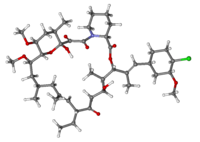Pimecrolimus
 | |
 | |
| Clinical data | |
|---|---|
| Trade names | Elidel |
| AHFS/Drugs.com | Monograph |
| Pregnancy category |
|
immunosuppressant | |
| ATC code | |
| Legal status | |
| Legal status | |
| Pharmacokinetic data | |
| Bioavailability | low systemic absorption |
| Protein binding | 74%–87% |
| Metabolism | Hepatic CYP3A |
| Identifiers | |
| |
JSmol) | |
| |
| |
| | |
Pimecrolimus is an
It is available as a topical cream. It was developed and formerly marketed by Novartis under the trade name Elidel.
Medical uses
It has been proven to be effective in various
Atopic dermatitis
If topical corticosteroids and moisturisers fail in the treatment of atopic dermatitis, short-term treatment with topical calcineurin inhibitors such as tacrolimus or pimecrolimus may be tried. Both tacrolimus and pimecrolimus are effective and safe to use in AD.[9][10]
Side effects
In January 2006, the United States
Importantly, although the FDA has approved updated black-box warning for tacrolimus and pimecrolimus, the recent report of the American Academy of Dermatology Association Task Force finds that there is no causal proof that topical immunomodulators cause lymphoma or nonmelanoma skin cancer, and systemic immunosuppression after short-term or intermittent long-term topical application seems an unlikely mechanism.[12] Another recent review of evidence concluded that postmarketing surveillance shows no evidence for this systemic immunosuppression or increased risk for any malignancy.[13]
A 2023 systematic review and meta-analysis published in
Pharmacology
Pimecrolimus is an
Pimecrolimus, like
Development and Production
Pimecrolimus was developed by Novartis. Its development number was ascomycin derivative ASM 981.[22]
The NDA was filed December 15, 2000. It received US FDA approval on December 13, 2001.[23] At its US approval, it was one of the first new eczema treatments introduced since the topical corticosteroids of the 1950s.[24] It is available as a topical cream, once marketed by . Since early 2007, Galderma has been promoting the compound in Canada. The trade name is Elidel.
References
- FDA. Retrieved 22 Oct 2023.
- PMID 16924062.
- PMID 15337984.
- PMID 17658663.
- PMID 17324829.)
{{cite journal}}: CS1 maint: DOI inactive as of January 2024 (link - PMID 16983001.
- S2CID 35741213.
- PMID 15347485.
- PMID 26132597.
- S2CID 253470127.
- ^ Cox NH, Smith CH (December 2002). "Advice to dermatologists re topical tacrolimus". Therapy Guidelines Committee. British Association of Dermatologists. Archived from the original (DOC) on 2006-05-25.
- PMID 16635663.
- S2CID 40761750.
- S2CID 253470127.
- PMID 16983018.
- ^ "Statement Regarding FDA Decision On Two Eczema Medications By American Academy Of Dermatology". Archived from the original on 2008-04-07. Retrieved 2007-09-24.
- PMID 15940142.
- PMID 14612358.
- S2CID 26517363.
- PMID 14698574.
- S2CID 34706897.
- PMID 11907497.
- ^ "Application No.: 21-302 Elidel (Pimecrolimus) Cream". US DHHS. Retrieved 11 April 2024.
- ^ "US SEC FORM 20-F NOVARTIS AG filed January 31, 2007" (PDF). www.novartis.com. NOVARTIS Inc. 31 January 2007. Retrieved 11 April 2024.
External links
- FDA News
- NPS RADAR
- Statement Regarding FDA Decision on Two Eczema Medications by American Academy of Dermatology at the Wayback Machine (archived 2008-04-07)
